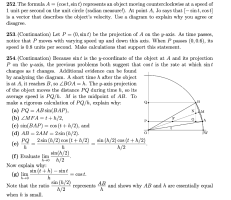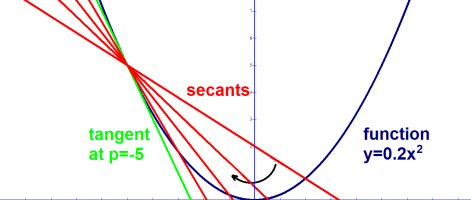i think if i write the curve as \(\displaystyle A\) or \(\displaystyle \bold{r}\) or \(\displaystyle \bold{r}(t)\) or \(\displaystyle \boldsymbol{\gamma}(t)\) i'm not change the properties of the curve right?
No, you can use a letter whatever you want. However, there are standards that help reading and writing a lot. [imath] \mathbf{r} [/imath] is usually a radius, and we do not have a radius as a variable here. We have [imath] \mathbf{r} =\mathbf{r}(t)=1[/imath]. If you choose [imath] r [/imath] as your path name it will be a matter of time until you get confused with the constant radius in the example.
[imath] A [/imath] is even worse since it is normally used as the notation of an area.
if i study curves they use interchangebly \(\displaystyle \bold{r}(t)\) and \(\displaystyle \boldsymbol{\gamma}(t)\). i think \(\displaystyle \boldsymbol{\gamma}(t)\) is the best notation for curves
... which we do have here. A curve (a circle) that we follow from timestamp [imath] t=0 [/imath] to timestamp [imath] t=2\pi. [/imath]
If I use [imath] t\mapsto \gamma(t) [/imath] as a general path, and [imath] \gamma(t)=(x(t),y(t))=(\cos(t),\sin(t)) [/imath] I can calculate everything and still have the letters [imath] r [/imath] and [imath] A [/imath] in hand, in case we consider different circles with arbitrary or even changing radii, or want to calculate the area [imath] A=\pi. [/imath] It makes no sense to create confusion.
you're using the notation of sphere \(\displaystyle \mathbb{S}\) for our curve. why? why it's a subset of \(\displaystyle \mathbb{R}^2\) and not a proper subset?
It is a circle of radius one. Its official name is unit circle or unit sphere, and its official notation is [imath] \mathbb{S}^1. [/imath] The power one denotes the fact that it is one-dimensional, although embedded in the two-dimensional Euclidean plane [imath] \mathbb{R}^2 .[/imath]
I always use [imath] \subseteq [/imath] because a) it is a shortcut on my keyboard and b) I do not want to even think about equality. Everybody knows that a circle isn't the entire plane. [imath] \subset [/imath] or [imath] \subsetneq [/imath] would pay way too much attention to that fact: why did he emphasize this triviality, are there examples where equality holds, etc. All senseless questions that could come up if I emphasized the strict inequality. [imath] \subseteq [/imath] is simply my default notation.
is it wrong to say that our circle is a proper subset of \(\displaystyle \mathbb{R}^2\)?
Of course not, but why? It's trivial.
i'm caring about the notation because i study them carefully and wanna be correct when i write them in future questions.
Notations are arbitrary, but conventions are not. Your exercise considers two different curves, one of which happens to be a circle. However, the shape is completely irrelevant to the questions about speed. Speed is a local quantity: speed to a certain moment in time! Again, the speed on the circle happens to be constant because of a famous formula involving the sine and the cosine of an angle (here a time). This is the result of a computation, not a given fact! The other curve is [imath] t\mapsto (0,\sin(t)) [/imath] which doesn't have a constant speed. Btw., the speed around the circle may be constant, but the velocity is not!
This means the circle itself becomes irrelevant (except for that formula) and is the reason I spoke of [imath] \gamma [/imath] instead. No radius [imath] \boldsymbol r [/imath] and no area [imath] \boldsymbol A, [/imath] only Pythagoras.
i think the speed and the velcity is confuse me a lot in the last questions i posted. i don't know it precisely and it is like the speed we don't care about the direction. i'm confused when you included \(\displaystyle \boldsymbol{\gamma}_0\) to our curve \(\displaystyle \boldsymbol{\gamma}\)
I only introduced [imath] \gamma_0 [/imath] to distinguish it from the circle that I used [imath] \gamma [/imath] for. Two curves, two names. Otherwise, we will get a mess. The geometry doesn't play a role for the calculations.
Physicists avoid the word speed at all. They do not use it. It is a velocity, which is a vector, not a number. It is the vector you follow when you lose traction on a road, and its length, i.e. how far you will be cast into the wilderness. This length is commonly named speed, but physicists speak of the norm or the length of the velocity vector instead. With only one exception: the speed of light. But that is because of historical reasons.
what do you mean by the zero in \(\displaystyle \boldsymbol{\gamma}_0\)? i'm just confused by the notation
I meant that I needed something to distinguish between [imath] t\mapsto \gamma(t)=(\cos(t),\sin(t)) [/imath] and [imath] t\mapsto \gamma_0(t)=(0,\sin(t)) .[/imath] I could have chosen any other letter instead, but many of them have their own conventions and we are still talking about curves, or paths along curves.



